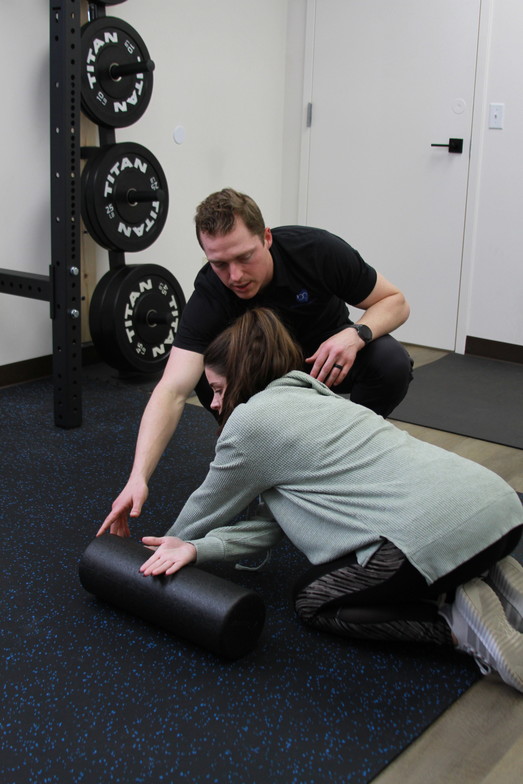
Introduction: The Confusing Message About Pain
“Your pain is in your head.”
If you’ve ever heard that, your first reaction was probably annoyance—or worse, feeling dismissed. Pain feels very real in your back, knee, or shoulder, so how can it be “in your head”?
Here’s the nuance: all pain is processed by the nervous system—particularly the brain—but that doesn’t mean it’s imaginary. Think of pain as your body’s alarm system. Sometimes the alarm is accurate; sometimes it becomes hypersensitive after an “emergency” (injury) has already been handled. Understanding—and then resetting—that sensitive alarm is the key to long-term, movement-based recovery.
What Exactly Is a Pain Buffer?

Check out the graphic above. You’ll see two yellow squiggles—representing your activity level—moving up toward horizontal white lines.
-
Pre-Injury (Left Side)
-
Lower white line: your pain threshold.
-
Upper yellow line: tissue damage threshold (where you actually risk injury).
-
The space between the two is your pain buffer—a healthy safety zone.
-
-
Post-Injury (Right Side)
-
Your pain threshold plunges, sometimes dramatically. Now it takes far less activity to trigger pain—well before any real tissue damage occurs.
-
Result: walking, lifting groceries, or your favorite workout feels threatening. You avoid movement, which further weakens tissues and enlarges the buffer. That vicious cycle can fuel chronic pain.
-
Why Does the Buffer Get Too Big?
| Factor | How It Expands the Buffer |
|---|---|
| Neural Sensitization | After an injury, the spinal cord and brain amplify incoming danger signals to protect you. |
| Inflammation & Immobility | Swelling + rest = fewer motion signals to calm the brain, so danger signals dominate. |
| Fear-Avoidance Beliefs | “If it hurts, I’ll damage it.” You move less, tissues de-condition, threshold drops further. |
| Stress & Poor Sleep | Cortisol spikes and sleep debt reduce your natural pain-modulating chemicals. |
Understanding these drivers matters because every one of them is modifiable through movement, load management, and education—core pillars of the rehab approach at Bergner Chiropractic.
The Hot-Tub Analogy: Graded Exposure 101
Remember dipping just a toe into a hot tub? If you jumped in, you’d yell—but gradual immersion feels pleasant.
Graded exposure works the same way for pain:
-
Find Today’s Edge
-
Choose an activity that provokes mild pain—say, a 3/10 on the pain scale—that eases within 24 hours. For runners it might be ¼-mile jogs; for golfers, 25 practice swings.
-
-
Dip the Toe
-
Perform just enough reps or distance to reach that 3/10 discomfort, not more.
-
-
Adapt & Repeat
-
Track your response (pain journal or app). If soreness is no worse next day, you’ve told your brain “this is safe.” That nudges the pain threshold upward.
-
-
Progress Systematically
-
Increase load or volume by 10 % each session or week (the classic sports-medicine rule). Over months, the buffer shrinks; capacity climbs.
-
Step-by-Step Example for Active Adults
| Week | Activity | Progression Cue |
|---|---|---|
| 1 | 5 body-weight squats to seat height | Stop at 3/10 discomfort |
| 2 | 2 × 8 squats, add light kettlebell | Same pain cap |
| 3 | 3 × 10 goblet squats, deeper box | Pain <3/10 within 24 h |
| 4 | Return to unloaded barbell back squats | Keep 10 % load jumps weekly |
This template applies to running mileage, pull-ups, or overhead presses. The principle is always small, consistent challenges to the nervous system—until it trusts the joint or muscle again.
Frequently Asked Questions
Is pushing into pain safe?
Yes—as long as pain stays mild and short-lived. Research on chronic low-back pain and tendinopathies shows graded exposure outperforms rest-only strategies.
How long until my pain buffer “normalizes”?
Most active adults see meaningful improvements in 4-6 weeks; full capacity often returns within 3-6 months, depending on injury severity and training consistency.
Do I still need manual therapy or adjustments?
Hands-on care (joint manipulation, soft-tissue work, dry needling) can calm hypersensitive tissues, making graded exercise more comfortable. At Bergner Chiropractic we blend both so you feel and move better—faster.
When to Get Professional Guidance
-
Pain persists >3 months or worsens despite self-programming.
-
You’ve developed fear of specific lifts—e.g., deadlifts, overhead presses—and want form coaching.
-
You’re an endurance athlete (runners, CrossFitters, golfers, pickleballers) aiming to peak for events without flare-ups.
A movement assessment identifies the exact motions triggering your nervous system, then maps out a step-by-step loading plan so every rep builds confidence—not alarm.
Key Takeaways
-
Pain is an output of the brain, not a direct measure of damage.
-
Injury can enlarge your pain buffer, causing pain long before harm.
-
Graded exposure—dipping your toe—systematically shrinks that buffer.
-
Education + progressive strength + mobility training = resilient recovery.
Ready to Shrink Your Pain Buffer?
If pain is sidelining your workouts, adventures, or daily life, you don’t have to navigate rehab alone. At Bergner Chiropractic in Overland Park, we specialize in blending evidence-based chiropractic, strength & mobility programming, and 1-on-1 coaching for active adults across Kansas City.
Book a free Discovery Call by hitting the "Book a Free Consultation" button in the top right to see if our 3-pillar approach (assessment, custom exercise, ongoing support) is right for you. Your brain—and body—will thank you.
Dr. Luke Bergner
Contact Me

